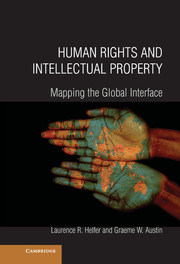Book contents
- Frontmatter
- Contents
- Preface
- 1 Mapping the Interface of Human Rights and Intellectual Property
- 2 The Human Right to Health, Access to Patented Medicines, and the Restructuring of Global Innovation Policy
- 3 Creators' Rights as Human Rights and the Human Right of Property
- 4 Rights to Freedom of Expression, to Cultural Participation, and to Benefit from Scientific Advancements
- 5 The Right to Education and Copyright in Learning Materials
- 6 The Human Right to Food, Plant Genetic Resources, and Intellectual Property
- 7 Indigenous Peoples' Rights and Intellectual Property
- 8 Conclusion
- References
- Acknowledgments
- Index
- Cases Discussed (Selected)
6 - The Human Right to Food, Plant Genetic Resources, and Intellectual Property
Published online by Cambridge University Press: 05 June 2012
- Frontmatter
- Contents
- Preface
- 1 Mapping the Interface of Human Rights and Intellectual Property
- 2 The Human Right to Health, Access to Patented Medicines, and the Restructuring of Global Innovation Policy
- 3 Creators' Rights as Human Rights and the Human Right of Property
- 4 Rights to Freedom of Expression, to Cultural Participation, and to Benefit from Scientific Advancements
- 5 The Right to Education and Copyright in Learning Materials
- 6 The Human Right to Food, Plant Genetic Resources, and Intellectual Property
- 7 Indigenous Peoples' Rights and Intellectual Property
- 8 Conclusion
- References
- Acknowledgments
- Index
- Cases Discussed (Selected)
Summary
Introduction
The intersection of intellectual property and the human right to food raises contentious and unresolved issues of international law and politics. Analysis of these issues is made even more challenging by two distinct but related developments – (1) the diversity and complexity of the rules and institutions that regulate the creation, ownership, and exploitation of plant genetic resources (PGRs) for food and agriculture and of the biotechnologies used to manipulate them, and (2) the expansion, over the last quarter century, of the normative content of the human right to food and of intellectual property rights for plant-related innovations.
The first development – the diversity and complexity of the legal and institutional landscape – stems from the fact that the international rules governing PGRs and agrobiotechnologies include not only multilateral intellectual property agreements, the International Covenant on Economic Social and Cultural Rights (ICESCR), and customary human rights law, but also treaties, declarations, and resolutions adopted under the auspices of the World Trade Organization (WTO), the Food and Agriculture Organization (FAO), the Convention on Biological Diversity, the Commission on Genetic Resources for Food and Agriculture, and regional organizations such as the European and African Unions and the Andean Community. Scholars have labeled this dense thicket of overlapping rules and institutions as a “regime complex” for PGRs. And they have explained how the existence of multiple negotiating forums within the complex enable governments and public interest NGOs to shift from one venue to another and to select the venue most conducive to advancing their preferred legal and policy outcomes.
- Type
- Chapter
- Information
- Human Rights and Intellectual PropertyMapping the Global Interface, pp. 364 - 431Publisher: Cambridge University PressPrint publication year: 2011
- 1
- Cited by



